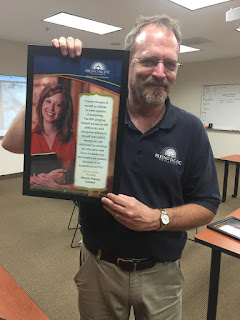Keltic Ken's response:
--------------
Interview with the pastor about this:
Coffee shop prank
These were to remind us of how shocking, subversive, surprising Jesus' temple tantrum was.
Here's BSN 12 getting pranked. Click here
---
--
==
Click HERE for live webcam to Wailing Wall of the temple
--
SOREQ
Temple Warning Inscription:
The Jewish Temple in Jerusalem was surrounded by a fence (balustrade) with a sign (soreq) that was about 5 ft. [1.5 m.] high. On this fence were mounted inscriptions in Latin and Greek forbidding Gentiles from entering the temple area proper.
One complete inscription was found in Jerusalem and is now on display on the second floor of the “Archaeological Museum” in Istanbul.
The Greek text has been translated: “Foreigners must not enter inside the balustrade or into the forecourt around the sanctuary. Whoever is caught will have himself to blame for his ensuing death.” Compare the accusation against Paul found in Acts 21:28 and Paul’s comments in Ephesians 2:14—“the dividing wall.”
Translation from Elwell, Walter A., and Yarbrough, Robert W., eds. Readings from the First–Century World: Primary Sources for New Testament Study. Encountering Biblical Studies, general editor and New Testament editor Walter A. Elwell. Grand Rapids, MI: Baker, 1998, p. 83. Click Here
-----
Three thought experiments.
- -Think if I offered you a drivers license, claiming i had authority to issue it
- -Think if someone destroyed all bank records and evidence of any debt you have owe
- -Think what would happen if you pointed at something, hoping your dog would look at it.
Now watch this short and important video for explanations...Temple as SIGN-post.

The Jewish Temple in Jerusalem was surrounded by a fence (balustrade) with a sign (soreq) that was about 5 ft. [1.5 m.] high. On this fence were mounted inscriptions in Latin and Greek forbidding Gentiles from entering the temple area proper.One complete inscription was found in Jerusalem and is now on display on the second floor of the “Archaeological Museum” in Istanbul.The Greek text has been translated: “Foreigners must not enter inside the balustrade or into the forecourt around the sanctuary. Whoever is caught will have himself to blame for his ensuing death.” Compare the accusation against Paul found in Acts 21:28 and Paul’s comments in Ephesians 2:14—“the dividing wall.”Translation from Elwell, Walter A., and Yarbrough, Robert W., eds. Readings from the First–Century World: Primary Sources for New Testament Study. Encountering Biblical Studies, general editor and New Testament editor Walter A. Elwell. Grand Rapids, MI: Baker, 1998, p. 83. Click Here
-----
Three thought experiments.- -Think if I offered you a drivers license, claiming i had authority to issue it
- -Think if someone destroyed all bank records and evidence of any debt you have owe
- -Think what would happen if you pointed at something, hoping your dog would look at it.

Wright:
For many centuries mapmakers put Jerusalem at the middle of the earth. That corresponds to what most Jews in the first century believed about the city, and particularly about the Temple. It was the heart of everything, the holiest spot on earth. It was the focal point of the holy land. Its decoration symbolized the larger creation, the world we read about in Genesis 1. It wasn’t, as sacred buildings have been in some other traditions, a retreat from the world. It was a bridgehead into the world. It was the sign that the creator God was claiming the whole world, claiming it back for himself, establishing his domain in the middle of it.
It was, in particular, the place where God himself had promised to come and live. This was where God’s glory, his tabernacling presence, his Shekinah, had come to rest. That’s what the Bible had said, and some fortunate, though frightened, individuals had glimpsed it and lived to tell the tale. But God lived, by definition, in heaven. Nobody, however, supposed that God lived most of the time in heaven, a long way away, and then, as though for an occasional holiday or royal visitation, went to live in the Temple in Jerusalem instead.
Somehow, in a way most modern people find extraordinary to the point of being almost unbelievable, the Temple was not only the center of the world. It was the place where heaven and earth met. This isn’t, then, just a way of saying, “Well, the Jews were very attached to their land and their capital city.” It was the vital expression of a worldview in which “heaven” and “earth” are not far apart, as most people today assume, but actually overlap and interlock.
And Jesus, had been going about saying that this God, Israel’s God, was right now becoming king, was taking charge, was establishing his long-awaited saving and healing rule on earth as in heaven. Heaven and earth were being joined up — but no longer in the Temple in Jerusalem. The joining place was visible where the healings were taking place, where the party was going on (remember the angels celebrating in heaven and people joining in on earth?), where forgiveness was happening. In other words, the joining place, the overlapping circle, was taking place where Jesus was and in what he was doing. Jesus was, as it were, a walking Temple. A living, breathing place-where-Israel’s-God-was-living.
 |
| Pastor D.J. Criner |
and challenge the students to practice presenting anything they've learned.
It's totally up to them: they can tea- teach it, one person can present etc.
Sometimes I am even brave/dumb enough to say they can choose someone to impersonate (roast/toast( me and my style.
I should have known that with the delightful and daring Pastor D.J. Criner (of Saint Rest Baptist Church) in class, that the class would choose him for that impersonation option (:
It was caught on video ...
Be sure to catch his whiteboard artwork of me. as well:


















No comments:
Post a Comment